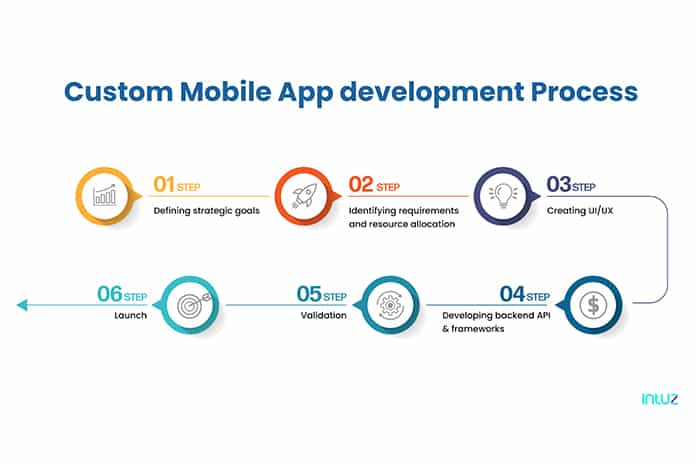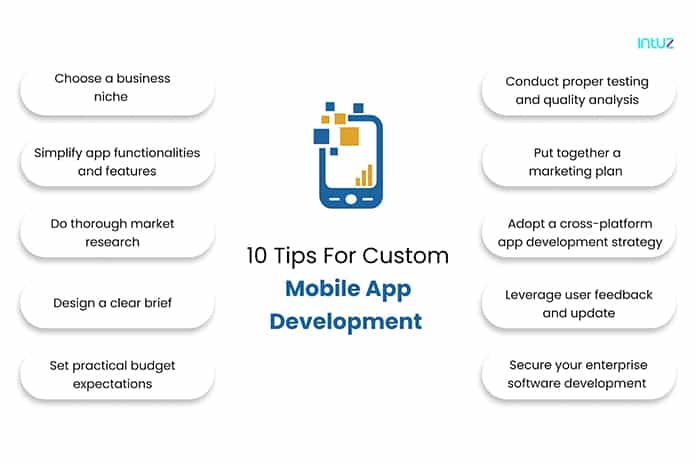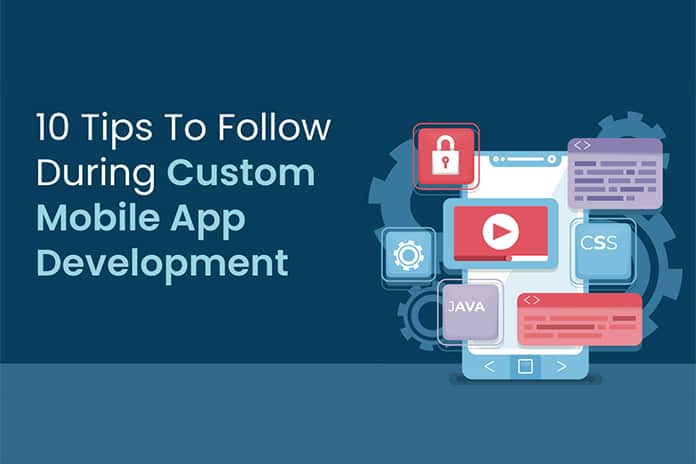Do you know mobile apps are expected to generate $189 billion in revenue via app stores and in-app advertising by 2020? That isn’t surprising since the average smartphone owner uses 30 apps every month. What’s more, 49% of consumers open an app more than 11X in a day.
There’s no doubt about the significance that mobile apps have in our daily lives – from purchasing groceries and clothing to booking cabs and movie tickets – there’s an app for everything, and for a good reason!
But the industry that’s actually flourishing is that of the native and hybrid mobile app development market. With so many apps being developed left, right, and center, the developers have never been busier.
Investing in a mobile app is nearly as important as setting up a physical shop for businesses. However, what companies don’t understand is that custom mobile app development is a complex process – one that involves the following steps:
-
- Defining strategic goals for evolving a mere idea into an app
- Identifying requirements, defining team structure, and preparing a product map
- Creating effortless user experience with a polished app UI/UX
- Developing backend API and best frontend frameworks
- Validating the mobile app with a series of testing criteria

- Launching the mobile app on the app stores with support for future upgrades
Despite the hard work that goes into creating apps, 80-90% of mobile apps launched in the app store are abandoned after being used once. Therefore, if you’re considering developing a mobile app but want to cover all your bases to ensure its success, here are ten tips to follow to boost the success ratio of your mobile app:
1. Choose A Business Niche
Take any mobile app development company, and the first question they’ll ask you is: “what objective do you want to fulfill via a mobile app?” if you think copying a flourishing business model (e.g., Uber) will guarantee your app’s success, you are mistaken.
Any mobile app’s commercial success rate is not more than 0.01%. That shows you need to define your business objective and customer requirements clearly. If having a mobile app can simplify your customers’ lives, carry on with the custom mobile app development process.
However, if you don’t think there’s any need for a mobile app and customers are happy purchasing through the desktop, drop the plan. The mobile app development process cost is enormous – you don’t need to put your business through that financial burden.
So, ask yourself: how can my mobile app deliver a unique value to my customers? If you need help defining your mobile app business idea, use tools such as Personas and Product Canvas.
2. Simplify App Functionalities And Features
It’s great to develop a mobile app that has all the features that one can think of! But do you know feature overload can make the app cumbersome? Moreover, it also increases the duration and cost of mobile app development.
Therefore, focus on a handful of unique features in the app and see how your customers react to them. You can always introduce extra features based on feedback and enhance the current functionalities over time. But choose quality over quantity.
Your mobile app is supposed to simplify customers’ lives, not complicate them with navigational problems, useless imagery, irrelevant animation, and undesigned user journeys.
3. Do Thorough Market Research
Hailo was a British technology company which matched Black Cabs in London to passengers. After its success in the native market, the company decided to do something similar with Yellow Cabs in New York City.
Unfortunately, within a year, Hailo pulled out of the North American market. Do you know why? Because in NYC, Yellow Cabs are always available, and consumers don’t need an app to book or schedule one.
Reports also revealed Hailo had 80% rejection on Yellow Cab orders because consumers at that time caught another Yellow Cab. This shows that market research is key to successful custom mobile app development.
Therefore, conduct analyses of competitors, the target audience and geography, and your business’ strengths and weaknesses. It would help if you considered all possible shortcomings, including cybersecurity issues, time to acquire the target clientele, maintenance expenses, and more.
4. Design A Clear Brief
Whether you work with an in-house mobile developer or a custom mobile app development company, you must share a clear brief with them. Make them understand the exact features and functionalities you need in a mobile app.
Explain what has to happen when the consumer clicks a specific button or which screen should appear after a particular action. Please provide them with a helicopter view of a project via diagrams, flowcharts, and sample sketches of the screens.
You will only fetch results when there is transparency about each task in the custom mobile app development process, and open communication is encouraged.
5. Set Practical Budget Expectations
A clear brief will also help you, and the custom mobile app development company set up a realistic budget. Depending upon the app’s complexity and functionality, the bespoke mobile app development may take several weeks to a few months.
Therefore, it’s necessary to do a preliminary assessment on how much app development costs and hold discussions regarding development requirements with the internal team and custom mobile app development company to plan developing an app for your business up to the cent.
6. Conduct Proper Testing And Quality Analysis
According to Statista, over 111 thousand mobile apps were released through the Google Play Store in 2020. The number of iOS mobile apps released, on the other hand, is 31.8 thousand. No wonder the custom mobile app development industry is such a competitive one.
Unfortunately, some companies mistake not testing the app before rolling it out on the app stores. You must understand how important the quality of your mobile app is. It’s not just about satisfying customers but also giving your brand image a boost.
Therefore, to ensure your app doesn’t fail, please do extensive beta testing and improve the app as per the feedback received.
7. Put Together A Marketing Plan
The mobile app marketing strategy is often ignored until the app is ready to launch in the market. It should not be like that. In fact, you must start planning your promotional efforts as soon as the app reaches the beta stage.
From promoting it on your business website and company newsletters to writing about your new application on the company website and external trade publications – there is a lot you can do to maximize user attention.
According to SproutSocial, 45% of companies using social media have reduced marketing costs, and 24% of them that use it specifically for lead generation have witnessed a rise in revenue.

Not having a social media plan for your mobile app is a lost opportunity. Therefore, get creative with posting on social media – promote the mobile app USPs and run contests to boost installs. Keep the target audience engaged!
Run push notifications and paid ads to fuel your digital marketing efforts. Organize a webinar to educate the target audience about how your mobile app can alleviate their pain-points. You can also approach a mobile app development company that can also render app marketing services.
8. Adopt A Cross-platform App Development Strategy
Gone are those days when it was wise to build a mobile app for a single platform. Not anymore. Today, it is a given that if a mobile app is available on Google Play Store, it is also available on Apple Store. Thankfully, developers can now use the best frontend frameworks to create and deploy a single source code on multiple platforms.
This reduces custom mobile app development costs and shortens time to market by 1.8X, thus providing quick product updates. Tesla, Samsung, Airbnb, and Wix are popular examples that have adopted a cross-platform app development strategy.
9. Leverage User Feedback And Update
Once consumers start using your mobile app, they will share their thoughts, whether you like it or not. You would receive positive reviews from them, but if you get negative feedback, don’t dismiss that.
Those consumers are the ones who care, and hence, they invested the time to highlight areas that require improvement. See their feedback under the microscope and implement changes to make your mobile app more efficient.
As trees need to be continuously watered to grow, your mobile app also needs to be updated and tweaked to flourish. Without any improvements or enhancements, your app doesn’t have a chance to stand out in the crowd! Don’t let that happen.
10. Secure Your Enterprise Software Development
Mobile apps with five-star user experiences boast of having more than a beautiful user interface. Successful apps offer extraordinary features such as personalized notifications and proactive recommendations based on the consumers’ past activity and personal information while ensuring their data security.
Moreover, your existing infrastructure should be able to accommodate millions as soon as the mobile app takes off. It would help if you leveraged cloud and hybrid cloud solutions to protect consumer data and connected systems while ensuring real-time push capabilities, user authentication, permission management, and offline data synchronization.
Wrapping It Up
Do you want to build a successful mobile app? Follow the points mentioned above correctly. Not following any of them would be a huge (and very expensive) mistake for you. To make your life simpler, please hire a custom mobile app development company that can create an app that matches your requirements and fulfills your business objectives.
Success within this competitive landscape is possible only if supported by a precisely cultivated mobile app development process. Get started today!


